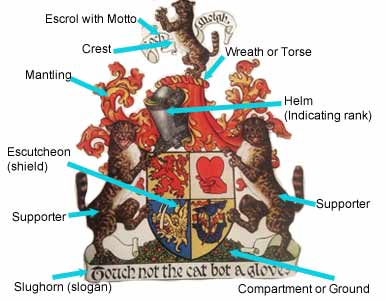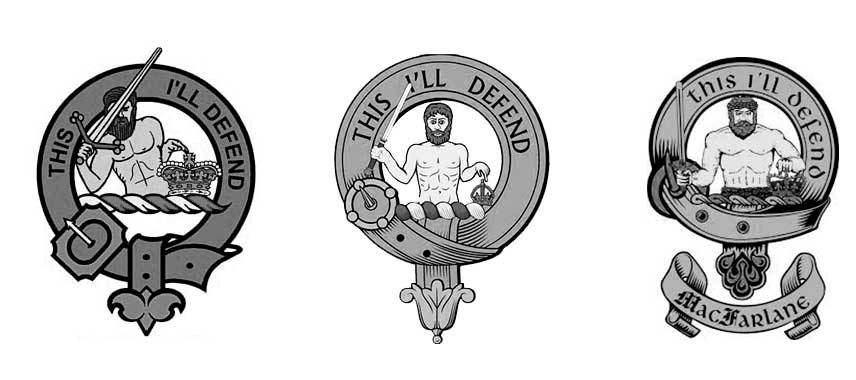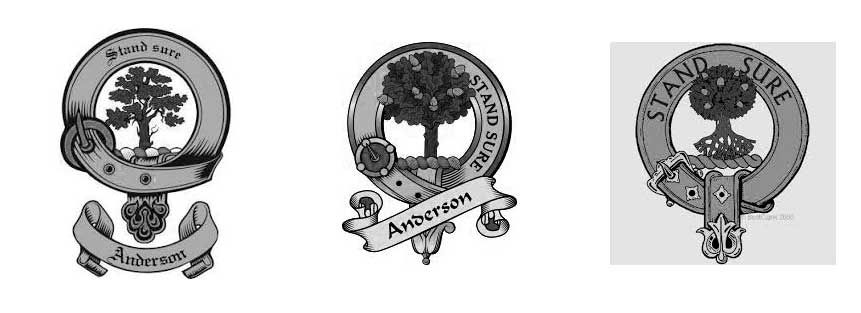There are a number of misconceptions around the subject of clan crests that we see popping up all the time – this short article will gather together the most common of these and hopefully put them to rest.
1 – I Have a Family Crest
We see this almost on a daily basis on our social media groups; someone invariably posts a picture of a coat of arms and then goes on to say that they are such and such clan and this is their family crest. Well not exactly!
First of all lets get the ‘coat of arms’ and ‘clan crest’ confusion sorted; In Scotland ‘arms’ are granted to an individual through the Court of the Lord Lyon. A coat of arms typically consists of a number of elements; the Shield – the Charge (the design that goes on the shield), The Helm, Wreath, Motto, Compartment (the ground that the arms sits on), Supporters (figures at either side of the arms) and the Crest. I have simplified this a great deal and we do have a much more detailed explanation of heraldry here:

A coat of arms is what is known as ‘Personal Heritable Property’ in other words it belongs to one person only and the arms can be passed down to one descendent – all other descendants can apply for arms which will have slight differences applied.
Medieval knights would often wear a design on top of their helmets normally shaped from leather as another form of battlefield recognition. This might take the shape of an animal or other object – this developed into the ‘crest’. Scottish clans are unique in that anyone who is aligned with the clan may wear or display a representation of this crest within a strap and buckle design – this is the ‘clan crest’ we are familiar with. The crest shows allegiance to the armiger (the individual who has been granted the arms) as head of the clan or family.
Sadly there are a lot of what we call ‘bucket shop arms’ going around – places where for a few of your hard earned pennies you can get a print out scroll with your surname history and coat of arms – these are utter bollocks – the surname information is fairly generic and you have as much right to the coat of arms as I have to declare myself king of Scotland just like Idi Amin. Wear the crest – be happy with that and for god’s sake don’t tattoo the arms on your body – its a little known fact that if you put a coat of arms on something then it then belongs to the armiger. Its a mark of ownership so unless you plan to become the personal slave to your clan chief then don’t do it.
2 – The Design of the Crest Should Look Exactly Like This.
This is a hard one for many people to understand – often we get people coming to us saying that the design on a crest should be of a particular style; maybe the deer should have this many points or there should be dots between the words on the motto. I can remember many years ago getting threatening letters from a gentlemen in the USA connected with the Urquhart clan who took exception to my drawing of the Urquhart crest (its a semi naked female). He demanded we use his rendition of the crest which frankly looked like a barmaid from ‘hooters’. We politely told him to ‘get tae…’
The bottom line is that a crest or indeed a coat of arms is down to the interpretation of the artist.
When someone is granted arms they are given what is called the ‘Letters Patent’ this is a very lovely document that includes what is called the ‘Blazon’ The Blazon is a text description of the arms using a sort of shorthand that anyone in Heraldry will understand. so for example the blazon may say ‘Or a Lion Rampant Gules’ (‘or’ is gold and ‘gules’ is red’) so that means a red lion rampant on a gold background. Now that gold can be any shade of gold and the red can be any shade of red – the lion can be anything that looks even vaguely like a lion as long as it shows the lion – facing the correct way and striking the correct pose.

If you look at these three interpretations of the MacFarlane crest above you can see that all have been drawn in a very different style but as long as each of them is a savage from the waist up holding a sword in his right hand and pointing to crown with his left then its the crest for MacFarlane in this instance the blazon reads “A demi-savage brandishing in his dexter a broad sword Proper and pointing with his sinister to an imperial crown or standing by him on the wreath.”
The blazon is simply the description of the arms and nothing else – this is what the armiger owns, not how it is interpreted. Think of it like a musical manuscript. You could play that music with a grand piano or a banjo – it makes no difference as its down to the musicians interpretation as long as they play the same notes in the same order it’s still the same music. Similarly it is down to how the heraldic artist interprets the blazon – as long as they stay within the brief set out on the blazon then it is a correct interpretation of the arms (and therefore the crest). Also by that same token the artist can’t add random elements to the design; if it says ‘A Lion Rampant’ then that is what it has to be, they cant add a crown, sword, bobble hat or furry baubles to the lion unless its on the blazon.
3 – The Motto Must be Centred
This has to be the number one cause of my forehead coming into contact with the desk. Even though it’s covered above this needs its own special mention.
As we have explained above the design of the crest is a matter for the individual artist’s interpretation within the confines of the blazon of arms. This also holds true for the placement of the motto. The motto on a clan crest must appear around the crest on the strap part of the strap and buckle. Now the buckle almost always sits around the 8 o’clock position on the strap so the usable area (i guess we could call it the ‘print safe’ area) on the strap is from 9 o’clock to around 5 o’clock (“9 to 5” – there must be a song about that). Now quite often to give the crest image a bit more impact the design will run over the strap (the stags horns or the point of a sword for example) This restricts how the motto will sit on the strap. The artist might chose to break the words around the intrusion or run the words on one or other side. They might even choose to run it ‘canted’ (tilted over to one side) to counterbalance the buckle and even up the design a bit. What they cant do is hyphenate a word or run words together but as long as its legible it can sit anywhere on the strap.
The following three examples of the Anderson Crest illustrate this well:

The first two are randomly plucked from the internet and the third is from ScotClans. In the first crest the tree is well inside the strap and the motto sits perfectly on top. On the second crest the oak tree extends over a large part of the strap so the motto runs on the right where there is the most space. On the third example the oak tree breaks partially over the strap so in this instance the motto sits on either side (which is fine if its more than one word but if the motto was only one word then it could really go either side)
None of the samples above are ‘wrong’ – they are all different interpretations of the same blazon.
4 – There Can Be Only One!
Apologies the the blatant quote from ‘Highlander’
When a new chief is appointed to the clan then the crest from their personal arms will be adopted as the crest for the clan that the clansmen will be permitted to wear and display. This is great if the clan has a current living chief and even when they pass on then the descendant who takes on the role of chief will probably inherit the arms ‘undifferenced’ so everything stays as is.
When there is no living chief or recognised head of the family then it all becomes a little more complicated. Often people will go back to the last recognised chief of the clan and adopt that crest. Again thats not too bad but as more and more people with Scottish roots want to use the concept of ‘clans’ to connect with their ancestry more often than not we have ‘clans’ pop up that never ever were clans to start with. This gets very messy because we arrive at a position where the clan crest is perhaps drawn from a prominent person who has been granted arms in Scotland. We then end up with several crests that might represent the same clan while none of them are technically wrong neither are they technically correct either, its a matter of personal choice.
A further spanner is thrown in when some clans are regarded both as clans in their own right and also as part of (septs of) other clans. Smith is a good example – this is an occupational name from ‘Blacksmith’ – every clan would have a blacksmith and it’s a name that appears all over Scotland. Some of the Smith name will want to align themselves with an armiger who was a Smith and use that crest while others prefer to use the most common clan name such as MacPherson – a similar situation arises with Taylor and Cameron.

Sometimes different armigers of the same surname will have crests that are identical but have different mottos in their arms so we end up with crest badges circulating with two different mottos (Morrison is a good example – but also some clans actually have two mottos!) Again neither are wrong but…
5 – The Clan Society Chooses Which Crest to Use
Let’s be clear about this – clan societies do an awful lot of work to raise the awareness of clans; they work tirelessly at clan gatherings and highland games and are a great way of connecting with the wider clan community. Without the work of clan societies, especially in the USA and in Canada then the worldwide interest in Scottish clans would be greatly diminished.
But at the end of the day the society has no legal ruling over heraldry just as it has no right to change the historical facts relating to that clan. They can advise its members about which crest they prefer but that’s as far as it goes – The Elton John Fan Club doesn’t control the output of Elton John and doesn’t tell the rest of the world which songs thy have to listen to – Clan societies are there to promote – not to dictate.
Some clan societies have applied for arms in their own right and these have been awarded as ‘society arms’ which are similar to arms awarded to a corporation. The crest taken from these can be worn by members of the society but the society cant force everyone to use their crest – the society is not the chief (unless the chief also runs the society).
—————— ——————— —————–
Hopefully this has helped clear up a few of the myths that surround clan crests.

Bear in mind this applies to the UK and members of clan societies using the crests as members. Other nations had somewhat different rules when people of the UK intermarried with their own. All kingdoms had equal rights with one another. It was explained to me by my paternal grandmother, a Hungarian, Croatian and Austro-Hungarian aristocrat from a well known family in her own right that when my grandfather allowed my father to marry my heavily Scots-descended mother, he calculated “sixteen quarterings” on the basis of her ancestral lines in which she had an armigerous DIRECT ancestor–even if said ancestor was 300 years ago. At that time, in 1947, Hungary was still officially a kingdom–a regency and titles still existed and the families still had properties and many Hungarian Americans and others actually hoped the UK and US would drive out the Soviet army and a full monarchy would resume. My grandparents were titled and expected that one or both of their sons, my father was, of course one, would be able to “return home.” Thus the selection of a wife was not the usual U.S. situation. The same thing happened in Polish and other European families who had branches in the U.S. and thought some members might return to Europe. Fabos, by the way is not my father’s family’s real surname: it was an old title adopted as as surname for branches who were exiled or temporarily proscribed against. My grandfather was exiled by Franz Josef, recalled by Karl, and then exiled again by Horthy (for having supported Karl (sigh)), and then again, of course by the communists. Ironically, despite all of this, there is still land in the family, if anyone were suicidal enough to try to take it up, and some seriously fouled up chains of conveyance in a rather large part of Somogy in Hungary.
Thanks – as we say in Scotland “Aye but Naw”. The article is specifically about Scottish Crests and Coats of Arms. Scotland has its own specific rules of heraldry governed by the Court of The Lord Lyon and Heraldry in England is governed by the College of Arms – Both are Royal appointments but are quite separate in the same way our legal systems are separate. Anyone who wears a clan crest badge aligned with a Scottish Clan is showing allegiance with that clan whether they are Scottish (not a UK) citizen or from anywhere else.
The sixteen quarterings “seize quarters” rule does not apply to descents from 16 armigerous ancestors, it applies to descent as an Heir of 16 armigerous ancestors. Perhaps that is to which your paternal grandfather was making reference, your statement is a little ambiguous.
Please advise clan crest for MacGregor/Greer.
Rodger, I notice that on some of your clan crest images the bitter end of the encircling strap is tucked at the bottom. On others, the bitter end is just flopped over. Am I correct in assuming there is not a correct or standard way the strap is finished off? I have a sterling silver Hamilton clan crest cap badge given to me in the early 1960s by my mother that has it flopped over. My recent searches on the internet for sterling silver crest badges shows them tucked. Pewter crest badges seem to be either or these days depending on the manufacturer.
Thank you for your information on the crest. Would you have any information on where I could find a good copy of The Henderson Coat Of Arms ? I am a member of Clan Henderson’s and have seen some really bad copies.